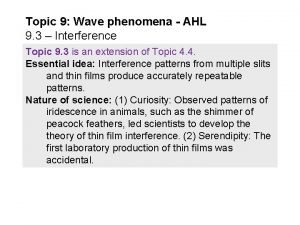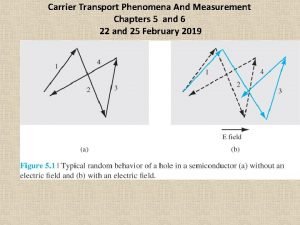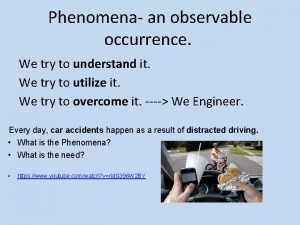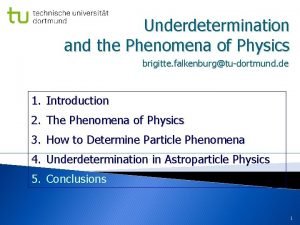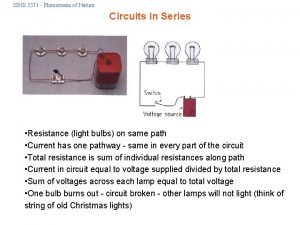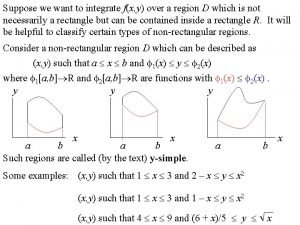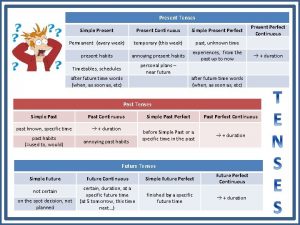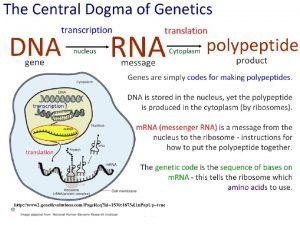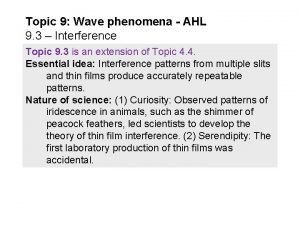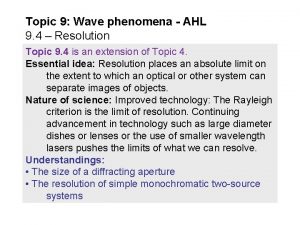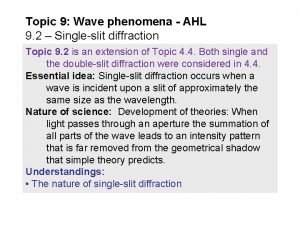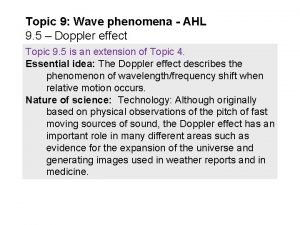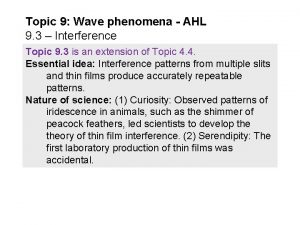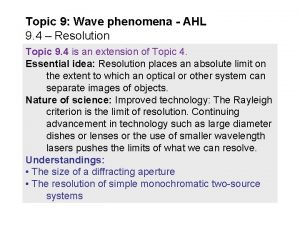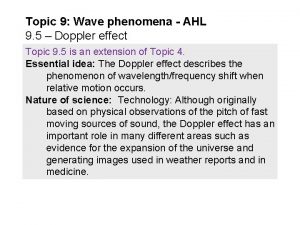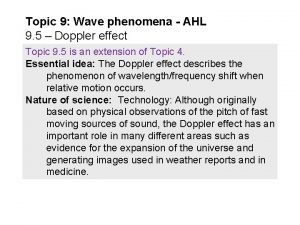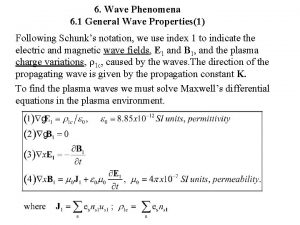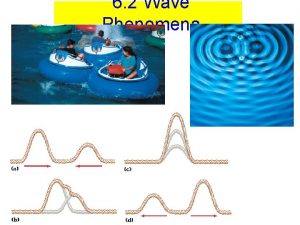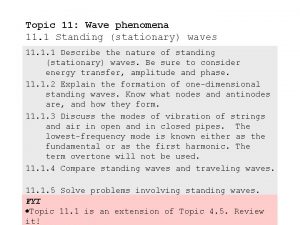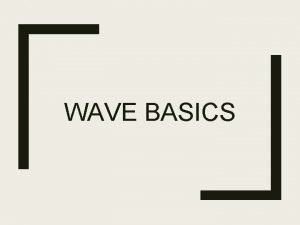Topic 9 Wave phenomena AHL 9 1 Simple

























































- Slides: 57

Topic 9: Wave phenomena - AHL 9. 1 – Simple harmonic motion Topic 9. 1 is an extension of Topic 4. 1. The new material begins on Slide 12 and ends on Slide 32. The rest is review. Essential idea: The solution of the harmonic oscillator can be framed around the variation of kinetic and potential energy in the system. Nature of science: Insights: The equation for simple harmonic motion (SHM) can be solved analytically and numerically. Physicists use such solutions to help them to visualize the behavior of the oscillator. The use of the equations is very powerful as any oscillation can be described in terms of a combination of harmonic oscillators. Numerical modeling of oscillators is important in the design of electrical circuits.

Topic 9: Wave phenomena - AHL 9. 1 – Simple harmonic motion Understandings: • The defining equation of SHM • Energy changes Applications and skills: • Solving problems involving acceleration, velocity and displacement during simple harmonic motion, both graphically and algebraically • Describing the interchange of kinetic and potential energy during simple harmonic motion • Solving problems involving energy transfer during simple harmonic motion, both graphically and algebraically

Topic 9: Wave phenomena - AHL 9. 1 – Simple harmonic motion Guidance • Contexts for this sub-topic include the simple pendulum and a mass-spring system Data booklet reference: • = 2 / T • a = - 2 x • x = x 0 sin t; x = x 0 cos t; • v = x 0 cos t; v = - x 0 sin t; • v = ± x 02 – x 2 • EK = (1/2)m 2 (x 02 – x 2) • ET = (1/2)m 2 x 02 • Pendulum: T = 2 L / g • Mass-spring: T = 2 m / k

Topic 9: Wave phenomena - AHL 9. 1 – Simple harmonic motion Utilization: • Fourier analysis allows us to describe all periodic oscillations in terms of simple harmonic oscillators. The mathematics of simple harmonic motion is crucial to any areas of science and technology where oscillations occur. • The interchange of energies in oscillation is important in electrical phenomena • Quadratic functions (see Mathematics HL sub-topic 2. 6; Mathematics SL sub-topic 2. 4; Mathematical studies SL sub-topic 6. 3) • Trigonometric functions (see Mathematics SL subtopic 3. 4)

Topic 9: Wave phenomena - AHL 9. 1 – Simple harmonic motion Aims: • Aim 4: students can use this topic to develop their ability to synthesize complex and diverse scientific information • Aim 6: experiments could include (but are not limited to): investigation of simple or torsional pendulums; measuring the vibrations of a tuning fork; further extensions of the experiments conducted in subtopic 4. 1.

Topic 9: Wave phenomena - AHL 9. 1 – Simple harmonic motion Aims: • Aim 6: By using the force law, a student can, with iteration, determine the behavior of an object under simple harmonic motion. The iterative approach (numerical solution), with given initial conditions, applies basic uniform acceleration equations in successive small time increments. At each increment, final values become the following initial conditions. • Aim 7: the observation of simple harmonic motion and the variables affected can be easily followed in computer simulations

Topic 9: Wave phenomena - AHL 9. 1 – Simple harmonic motion v=0 v = vmax FYI In all oscillations v = 0 at the extremes and v = vmax in the middle of the motion. v=0 Examples of oscillation Oscillations are vibrations which repeat themselves. EXAMPLE: They can be v=0 driven externally, like a pendulum in a gravitational field. EXAMPLE: They can be driven internally, like a mass on a spring. x

Topic 9: Wave phenomena - AHL 9. 1 – Simple harmonic motion Examples of oscillation Oscillations are vibrations which repeat themselves. EXAMPLE: They can be very rapid vibrations such as in a plucked guitar string or a tuning fork.

Topic 9: Wave phenomena - AHL 9. 1 – Simple harmonic motion m u i r b uili Describing oscillation eq Consider a mass on a spring that is displaced 4 meters to the right x and then released. x 0 We call the maximum displacement x 0 the amplitude. In this example x 0 = 4 m. We call the point of zero displacement the equilibrium position. The period T (measured in s) is the time it takes for the mass to make one complete oscillation or cycle. For this particular oscillation, the period T is about 24 seconds (per cycle).

Topic 9: Wave phenomena - AHL 9. 1 – Simple harmonic motion Describing oscillation The frequency f (measured in Hz or cycles / second) is defined as how many cycles (oscillations, repetitions) occur each second. Since period T is seconds per cycle, frequency must be 1 / T. f=1/T or T = 1 / f relation between T and f EXAMPLE: The cycle of the previous example repeated each 24 s. What are the period and the frequency of the oscillation? SOLUTION: The period is T = 24 s. The frequency is f = 1 / T = 1 / 24 = 0. 042 Hz

Topic 9: Wave phenomena - AHL 9. 1 – Simple harmonic motion Describing oscillation We can pull the mass to the right and then release it to begin its motion: start stretched x The two motions are half a cycle out of phase. start compressed x Or we could push it to the left and release it: The resulting motion would have the same values for T and f. However, the resulting motion will have a phase difference of half a cycle.

Topic 9: Wave phenomena - AHL 9. 1 – Simple harmonic motion Angular speed Before we define simple harmonic motion, which is a special kind of oscillation, we have to digress for a moment and revisit uniform circular motion. Recall that UCM consists of the motion of an object at a constant speed v 0 in a v 0 circle of radius x 0 Since the velocity is always changing direction, we saw that the object had a centripetal acceleration given by a = v 02 / x 0, pointing toward the center. If we time one revolution we get the period T. T is about 12 s. And the frequency is f = 1 / T = 1 / 12 = 0. 083 Hz.

Topic 9: Wave phenomena - AHL 9. 1 – Simple harmonic motion Angular speed We say that the angular speed of the object is = / t = 360 deg / 12 s = 30 deg s-1. In Topic 9 we must learn about an alternate and more natural method of measuring angles besides degrees. They are called radians. rad = 180° = 1/2 rev radian-degree-revolution 2 rad = 360° = 1 rev conversions EXAMPLE: Convert 30 into radians (rad) and convert 1. 75 rad to degrees. SOLUTION: 30 ( rad / 180° ) = 0. 52 rad. 1. 75 rad (180° / rad ) = 100°.

Topic 9: Wave phenomena - AHL 9. 1 – Simple harmonic motion Angular speed rad = 180° = 1/2 rev 2 rad = 360° = 1 rev radian-degree-revolution conversions Angular speed will not be measured in degrees per second in Topic 9. It will be measured in radians per second. EXAMPLE: Convert the angular speed of 30 s-1 from the previous example into radians per second. SOLUTION: Since 30 ( rad / 180° ) = 0. 52 rad, then 30 s-1 = 0. 52 rad s-1. FYI Angular speed is also called angular frequency. v 0 x 0

Topic 9: Wave phenomena - AHL 9. 1 – Simple harmonic motion Angular speed rad = 180° = 1/2 rev 2 rad = 360° = 1 rev radian-degree-revolution conversions Since 2 rad = 360° = 1 rev it should be clear that the angular speed is just 2 / T. = 2 / T = / t = 2 f relation between , T and f And since f = 1 / T it should also be clear that = 2 f. EXAMPLE: Find the angular frequency (angular speed) of the second hand on a clock. SOLUTION: Since the second hand turns through one circle each 60 s, it has an angular speed = 2 / T = 2 / 60 = 0. 105 rad s-1.

Topic 9: Wave phenomena - AHL 9. 1 – Simple harmonic motion Angular speed rad = 180° = 1/2 rev 2 rad = 360° = 1 rev = 2 / T = / t = 2 f radian-degree-revolution conversions relation between , T and f EXAMPLE: A car rounds a 90° turn in 6. 0 seconds. What was its angular speed during the turn? SOLUTION: Since needs radians we begin by converting : = 90°( rad / 180°) = 1. 57 rad. Now we use = / t = 1. 57 / 6 = 0. 26 rad s-1.

Topic 9: Wave phenomena - AHL 9. 1 – Simple harmonic motion Angular speed PRACTICE: Find the angular frequency of the minute hand of a clock, and the rotation of the earth in one day. The minute hand takes 1 hour to go around one time. Thus = 2 / T = 2 / 3600 s = 0. 0017 rad s-1. The earth takes 24 h for each revolution. Thus = 2 / T = ( 2 / 24 h )( 1 h / 3600 s ) = 0. 000073 rad s-1. This small angular speed is why we can’t really feel the earth as it spins.

Topic 9: Wave phenomena - AHL 9. 1 – Simple harmonic motion Angular speed PRACTICE: An object is traveling at speed v 0 in a circle of radius x 0. The period of the object’s motion is T. (a) Find the speed v 0 in terms of x 0 and T. Since the object travels a distance of one circumference in one period v 0 = distance / time v 0 = circumference / period v 0 = 2 x 0 / T. (b) Show that v 0 = x 0. v 0 Since v 0 = 2 x 0 / T and = 2 / T we have x 0 v 0 = 2 x 0 / T v 0 = x 02 / T v 0 = x 0(2 / T) v 0 = x 0

Topic 9: Wave phenomena - AHL 9. 1 – Simple harmonic motion Angular speed PRACTICE: An object is traveling at speed v 0 in a circle of radius x 0. The period of the object’s motion is T. (c) Find the centripetal acceleration a. C in terms of x 0 and . Since the centripetal acceleration is a. C = v 02 / x 0 and since v 0 = x 0 , v 02 = x 02 2 a. C = v 02/ x 0 a. C = x 02 2/ x 0 v 0 2 a. C = x 0

Topic 9: Wave phenomena - AHL 9. 1 – Simple harmonic motion x x 0 x 0 0 x 0 x 0 x 0 x x 0 0 The defining equation of SHM: a = - 2 x You might be asking yourself how an oscillating mass-spring system might be related to -x 0 uniform circular motion. The relationship is worth exploring. Consider a rotating disk that has a ball glued onto its edge. We project a strong light to produce a shadow of the ball’s motion on a screen. Like the mass in the mass-spring system, the ball behaves the same at the arrows: x

Topic 9: Wave phenomena - AHL 9. 1 – Simple harmonic motion x 0 v 0 0 x The defining equation of SHM: a = - 2 x Note that the shadow is the x-coordinate of the ball. Thus the equation of the -x 0 shadow’s displacement is x = x 0 cos . Since = / t we can write = t. Therefore the equation of the shadow’s x-coordinate is x = x 0 cos t. If we know , and if we know t, we can then calculate x. v 0 x 0 x x = x 0 cos

Topic 9: Wave phenomena - AHL 9. 1 – Simple harmonic motion x 0 The defining equation of SHM: a = - 2 x At precisely the same instant we can find the equation for the shadow of v. Create a velocity triangle. v 0 Working from the displacement triangle we can determine the 90 angles in the velocity triangle. - The x-component of the velocity is opposite theta, so we use sine: v = -v 0 sin . 90 But since = t and v 0 = x 0 we get our final equation: v = - x 0 sin t. Why is our v negative?

Topic 9: Wave phenomena - AHL 9. 1 – Simple harmonic motion x 0 The defining equation of SHM: a = - 2 x Remember the acceleration of the mass in UCM? We found recently that a. C = x 0 2. And we know that it points to the center. v 0 The x-component of the acceleration is adjacent to theta, so we use cosine: a = -a. C cos . But since = t and a. C = x 0 2 we get a. C our final equation: a = -x 0 2 cos t. Why is our a negative? Since x = x 0 cos t we can write a = - 2 x.

Topic 9: Wave phenomena - AHL 9. 1 – Simple harmonic motion The defining equation of SHM: a = - 2 x Let’s put all of our equations in a box – there are quite a few! = 2 / T Set 1 - equations of x = x 0 cos t v = - x 0 sin t = 2 f simple harmonic a = -x 0 2 cos t motion v 0 = x 0 a = - 2 x x 0 is the maximum displacement v 0 is the maximum speed This equation set works only for a mass which begins at x = +x 0 and is released from rest at t = 0 s. We say a particle is undergoing simple harmonic motion (SHM) if it’s acceleration is of the form a = - 2 x. The Data Booklet has the highlighted formulas.

Topic 9: Wave phenomena - AHL 9. 1 – Simple harmonic motion The defining equation of SHM: a = - 2 x Without deriving the other set in the Data Booklet, here they are: = 2 / T Set 2 - equations of x = x 0 sin t v = x 0 cos t = 2 f simple harmonic a = -x 0 2 sin t motion v 0 = x 0 a = - 2 x x is the maximum displacement 0 v 0 is the maximum speed This equation set works only for a mass which begins at x = 0 and is given a positive velocity v 0 at t = 0 s. This last set is derived by observing the shadow from a light at the left, beginning as shown: Data Booklet has highlighted formulas.

Topic 9: Wave phenomena - AHL 9. 1 – Simple harmonic motion The defining equation of SHM: a = - 2 x From Set 1: x = x 0 cos t, v = -v 0 sin t and v 0 = x 0 : Begin by squaring each equation from Set 1: x 2 = x 02 cos 2 t, v 2 = (- x 0 sin t)2 = x 02 2 sin 2 t. Now sin 2 t + cos 2 t = 1 yields sin 2 t = 1 – cos 2 t so that v 2 = x 02 2(1 – cos 2 t) or v 2 = 2(x 02 – x 02 cos 2 t). Then v 2 = 2(x 02 – x 2), which becomes v = x 02 – x 2 relation between x and v

Topic 9: Wave phenomena - AHL 9. 1 – Simple harmonic motion Solving SHM problems EXAMPLE: A spring having a spring constant of 125 n m-1 is attached to a 5. 0 -kg mass, stretched +4. 0 m as shown, and then released from rest. (a) Using Hooke’s law, show that the mass-spring system undergoes SHM with 2 = k / m. SOLUTION: Hooke’s law states that F = -kx. Newton’s second law states that F = ma. Thus ma = -kx or a = - (k / m)x. The result of a = - (k / m)x is of the form a = - 2 x where 2 = k / m. Therefore, the mass-spring system is in SHM. x

Topic 9: Wave phenomena - AHL 9. 1 – Simple harmonic motion Solving SHM problems EXAMPLE: A spring having a spring constant of 125 n m-1 is attached to a 5. 0 -kg mass, stretched +4. 0 m as shown, and then released from rest. (b) Find the angular frequency, frequency and period of the oscillation. SOLUTION: Since 2 = k / m = 125 / 5 = 25 then = 5 rad s-1. Since = 2 f, then f = / 2 = 5 / 2 = 0. 80 Hz. Since = 2 / T, then T = 2 / 5 = 1. 3 s. x

Topic 9: Wave phenomena - AHL 9. 1 – Simple harmonic motion Solving SHM problems EXAMPLE: A spring having a spring constant of 125 n m-1 is attached to a 5. 0 -kg mass, stretched +4. 0 m as shown, and then released from rest. (c) Show that the position and velocity of the mass at any time t is given by x = 4 cos 5 t and that v = -20 sin 5 t. SOLUTION: Note: 2 = k / m = 125 / 5 = 25 so = 5 rad s-1. Note: x 0 = 4 m, and v 0 = xo = 4(5) = 20 m s-1. At t = 0 s, x = +x 0 and v = 0, so use Set 1: x = x 0 cos t v = - xo sin t x = 4 cos 5 t v = -20 sin 5 t. x

Topic 9: Wave phenomena - AHL 9. 1 – Simple harmonic motion Solving SHM problems EXAMPLE: A spring having a spring constant of 125 n m-1 is attached to a 5. 0 -kg mass, stretched +4. 0 m as shown, and then released from rest. (d) Find the position, the velocity, and the acceleration of the mass at t = 0. 75 s. Then find the maximum kinetic energy of the system. SOLUTION: x = 4 cos 5 t = 4 cos (5 0. 75) = 4 cos 3. 75 = -3. 3 m. v = -20 sin 5 t = -20 sin (5 0. 75) = +11 m s-1. a = - 2 x = -52(-3. 3) = 83 m s-2. EK, max = (1/2)mv 02 = (1/2) 5 202 = 1000 J. x

Topic 9: Wave phenomena - AHL 9. 1 – Simple harmonic motion The period of a mass-spring system Because for a mass-spring system 2 = k / m and because for any system = 2 / T we can write T = 2 / k / m = 2 m / k T = 2 m / k Period of a mass-spring system PRACTICE: Find the period of a 25 -kg mass placed in oscillation on the end of a spring having k = 150 Nm-1. SOLUTION: T = 2 m / k = 2 25 / 150 = 2. 56 s. x

Topic 9: Wave phenomena - AHL 9. 1 – Simple harmonic motion The period of simple pendulum For a simple pendulum consisting of a mass on the end of a string of length L we have (without proof) = g / L. Then T = 2 / g / L T = 2 L / g L period of a simple pendulum PRACTICE: Find the period of a 25 -kg mass placed in oscillation on the end of a 1. 75 -meter long string. SOLUTION: T = 2 L / g = 2 1. 75 / 9. 8 = 2. 7 s.

Topic 9: Wave phenomena - AHL 9. 1 – Simple harmonic motion Solving SHM problems graphically and by calculation EXAMPLE: The displacement x vs. time t for a 2. 5 -kg mass is shown in the sinusoidal graph. (a) Find the period, the angular velocity, and the frequency of the motion. SOLUTION: The period is the time for one complete cycle. It is T = 6. 0 10 -3 s. = 2 / T = 2 / 0. 006 = 1000 rad s-1. [1047] f = 1 / T = 1 / 0. 006 = 170 Hz.

Topic 9: Wave phenomena - AHL 9. 1 – Simple harmonic motion Solving SHM problems graphically and by calculation EXAMPLE: The displace. Why is v ment x vs. time t for a negative? 2. 5 -kg mass is shown in the sinusoidal graph. (b) Find the velocity and acceleration of the mass Because at t = 3. 4 ms. the slope is! SOLUTION: From the graph x = -0. 8 10 -3 m at t = 3. 4 ms. From the graph x 0 = 2. 0 10 -3 m. Thus v = (x 02 - x 2) = -1047 (0. 0022 - 0. 00082) = -1. 9 m s-1. Finally a = - 2 x = -(10472)(-0. 0008) = +880 m s-2.

Topic 9: Wave phenomena - AHL 9. 1 – Simple harmonic motion Solving SHM problems graphically and by calculation PRACTICE: The displacement x vs. time t for a 2. 5 -kg mass is shown in the sinusoidal graph. (a) Find the period and the angular frequency of the mass. Then find the maximum velocity. The period is the time for one complete cycle. It is T = 6. 0 s. = 2 / T = 2 / 6 = 1. 0 rad s-1. [1. 047] v 0 = x 0 = 1. 4(1. 047) = 1. 5 m s-1.

Topic 9: Wave phenomena - AHL 9. 1 – Simple harmonic motion Solving SHM problems graphically and by calculation PRACTICE: The displacement x vs. time t for a 2. 5 -kg mass is shown in the sinusoidal graph. (b) Find the force acting on the mass at t = 3 s. Then find it’s velocity at that instant. Use F = ma where m = 2. 5 kg. At t = 3 s we see that x = -1. 4 m. Then a = - 2 x = -(1. 0472)(-1. 4) = 1. 5 m s-2. Then F = ma = 2. 5(1. 5) = 3. 8 n. Because the slope is zero, so is the velocity.

Topic 9: Wave phenomena - AHL 9. 1 – Simple harmonic motion Energy changes during SHM Consider the pendulum to the right which is placed in position and held there. Let the green rectangle represent the potential energy of the system. Let the red rectangle represent the kinetic energy of the system. Because there is no motion yet, there is no kinetic energy. But if we release it, the kinetic energy will grow as the potential energy diminishes. A continuous exchange between EK and EP occurs.

Topic 9: Wave phenomena - AHL 9. 1 – Simple harmonic motion Energy changes during SHM Consider the mass-spring system shown here. The mass is pulled to the right and held in place. Let the green rectangle represent the potential FYI energy of the system. Let the red rectangle If friction and drag are represent the kinetic both zero ET = CONST. energy of the system. A continuous exchange between EK and EP occurs. Note that the sum of EK and EP is constant. EK + EP = ET = CONST relation between EK and EP x

Topic 9: Wave phenomena - AHL 9. 1 – Simple harmonic motion Energy changes during SHM EK + EP = ET = CONST relation between EK and EP Energy If we plot both kinetic energy and potential energy vs. time for either system we would get the following graph: time x

Topic 9: Wave phenomena - AHL 9. 1 – Simple harmonic motion Energy changes during SHM EK + EP = ET = CONST relation between EK and EP Recall the relation between v and x that we derived in the last section: v = (x 02 – x 2). Then v 2 = 2(x 02 – x 2) (1/2)mv 2 = (1/2)m 2(x 02 – x 2) EK = (1/2)m 2(x 02 – x 2) relation between EK and x Recall that vmax = v 0 = x 0 so that we have EK, max = (1/2)mvmax 2 = (1/2)m 2 x 02. EK, max = (1/2)m 2 x 02 relation EK, max and x 0 These last two are in the Data Booklet.

Topic 9: Wave phenomena - AHL 9. 1 – Simple harmonic motion Energy changes during SHM EK + EP = ET = CONST relation between EK and EP EK, max = (1/2)m 2 x 02 relation EK, max and x 0 EXAMPLE: A 3. 00 -kg mass is undergoing SHM with a period of 6. 00 seconds. Its amplitude is 4. 00 meters. (a) What is its maximum kinetic energy and what is x when this occurs? SOLUTION: = 2 / T = 2 / 6 = 1. 05 rad s-1 and x 0 = 4. 00 m. EK, max = (1/2)m 2 x 02 = (1/2)(3. 00)(1. 052)(4. 002) = 26. 5 J. EK = EK, max = 26. 5 J when x = 0. x

Topic 9: Wave phenomena - AHL 9. 1 – Simple harmonic motion Energy changes during SHM EK + EP = ET = CONST relation between EK and EP EK, max = (1/2)m 2 x 02 relation EK, max and x 0 EXAMPLE: A 3. 00 -kg mass is undergoing SHM with a period of 6. 00 seconds. x Its amplitude is 4. 00 meters. (b) What is its potential energy when the kinetic energy is maximum and what is the total energy of the system? SOLUTION: EK = EK, max when x = 0. Thus EP = 0. From EK + EP = ET = CONST we have 26. 5 + 0 = ET = 26. 5 J.

Topic 9: Wave phenomena - AHL 9. 1 – Simple harmonic motion Energy changes during SHM EK + EP = ET = CONST relation between EK and EP EK, max = (1/2)m 2 x 02 relation EK, max and x 0 EXAMPLE: A 3. 00 -kg mass is undergoing SHM with a period of 6. 00 seconds. Its amplitude is 4. 00 meters. (c) What is its potential energy when the kinetic energy is 15. 0 J? SOLUTION: Since ET = 26. 5 J then From EK + EP = 26. 5 = CONST so we have 15. 0 + EP = 26. 5 J EP = 11. 5 J. x

Topic 9: Wave phenomena - AHL 9. 1 – Simple harmonic motion Energy changes during SHM EK + EP = ET = CONST relation between EK and EP EK = (1/2)m 2(x 02 – x 2) relation EK and x EK, max = (1/2)m 2 x 02 relation EK, max and x 0 Since EP = 0 when EK = EK, max we have E K + EP = ET EK, max + 0 = ET ET = (1/2)m 2 x 02 relation between ET and x 0 From EK = (1/2)m 2(x 02 – x 2) we get EK = (1/2)m 2 x 02 – (1/2)m 2 x 2 EK = ET – (1/2)m 2 x 2 ET = EK + (1/2)m 2 x 2 EP = (1/2)m 2 x 2 potential energy EP

Topic 9: Wave phenomena - AHL 9. 1 – Simple harmonic motion Energy changes during SHM ET = (1/2)m 2 x 02 relation between ET and x 0 EP = (1/2)m 2 x 2 potential energy EP EXAMPLE: A 3. 00 -kg mass is undergoing SHM with a period of 6. 00 seconds. Its amplitude is 4. 00 meters. Find the potential energy when x = 2. 00 m. Find the kinetic energy at x = 2. 00 m. SOLUTION: = 2 / T = 2 / 6 = 1. 05 rad s-1. x 0 = 4 m. ET = (1/2)m 2 x 02 = (1/2)(3)(1. 052)(42) = 26. 5 J. EP = (1/2)m 2 x 2 = (1/2)(3)(1. 052)(22) = 6. 62 J. ET = EK + EP so 26. 5 = EK + 6. 62 or EK = 19. 9 J. x

Topic 9: Wave phenomena - AHL 9. 1 – Simple harmonic motion Energy changes during SHM PRACTICE: A 2. 00 -kg mass is undergoing SHM with a period of 1. 75 s. x (a) What is the total energy of this system? = 2 / T = 2 / 1. 75 = 3. 59 rad s-1. x 0 = 3 m. ET = (1/2)m 2 x 02 = (1/2)(2)(3. 592)(32) = 116 J. (b) What is the potential energy of this system when x = 2. 50 m? EP = (1/2)m 2 x 2 = (1/2)(2)(3. 592)(2. 52) = 80. 6 J. FYI All of these problems assume the friction is zero. The potential energy formula is not on the Data Booklet.

Topic 9: Wave phenomena - AHL 9. 1 – Simple harmonic motion Energy changes during SHM PRACTICE: A 2 -kg mass is undergoing SHM with a displacement vs. time plot shown. (a) What is the total energy of this system? = 2 / T = 2 / 0. 3 = 20. 94 rad s-1. x 0 =. 0040 m. ET = (1/2)m 2 x 02 = (1/2)(2)(20. 942)(. 00402) =. 0070 J. (b) What is the potential energy at t = 0. 125 s? From the graph x = 0. 0020 m so that EP = (1/2)m 2 x 2 = (1/2)(2)(20. 942)(. 00202) =. 0018 J. (c) What is the kinetic energy at t = 0. 125 s? From EK + EP = ET we get EK +. 0018 =. 0070 so that Ek =. 0052 J.

Topic 9: Wave phenomena - AHL 9. 1 – Simple harmonic motion Sketching and interpreting graphs of SHM EXAMPLE: The kinetic energy vs. displacement for a system undergoing SHM is shown in the graph. The system consists of a 0. 125 -kg mass on a spring. (a) Determine the maximum velocity of the mass. SOLUTION: When EK is maximum, so is v. Thus 4. 0 = (1/ 2)mv. MAX 2 so that 4. 0 = (1/ 2)(. 125)v. MAX 2 -2. 0 -1 v. MAX = 8. 0 ms. 0. 0 2. 0 x

Topic 9: Wave phenomena - AHL 9. 1 – Simple harmonic motion Sketching and interpreting graphs of SHM EXAMPLE: The kinetic energy vs. displacement for a system undergoing SHM is shown in the graph. The system consists of a 0. 125 -kg mass on a spring. (b) Sketch EP and determine the total energy of the system. SOLUTION: Since EK + EP = ET = CONST, and since EP = 0 when EK = EK, MAX, it must be that -2. 0 ET = EK, MAX = 4. 0 J. Thus EP will be an “inverted” EK. ET EK EP 0. 0 2. 0 x

Topic 9: Wave phenomena - AHL 9. 1 – Simple harmonic motion Sketching and interpreting graphs of SHM EXAMPLE: The kinetic energy vs. displacement for a system undergoing SHM is shown in the graph. The system consists of a 0. 125 -kg mass on a spring. (c) Determine the spring constant k of the spring. SOLUTION: Use EP = (1/2)kx 2. EK = 0 at x = x. MAX = 2. 0 cm. Thus EK + EP = ET = CONST ET = 0 + (1/ 2)kx. MAX 2 so that -2. 0 2 4. 0 = (1/ 2)k 0. 020 k = 20000 Nm-1. 0. 0 2. 0 x

Topic 9: Wave phenomena - AHL 9. 1 – Simple harmonic motion Sketching and interpreting graphs of SHM EXAMPLE: The kinetic energy vs. displacement for a system undergoing SHM is shown in the graph. The system consists of a 0. 125 -kg mass on a spring. (c) Determine the acceleration of the mass at x = 1. 0 cm. SOLUTION: Use F = -kx. Thus F = -20000(0. 01) = -200 N. From F = ma we get -200 = 0. 125 a -2. 0 -2 a = -1600 ms. 0. 0 2. 0 x

Topic 9: Wave phenomena - AHL 9. 1 – Simple harmonic motion Sketching and interpreting graphs of SHM EXAMPLE: A 4. 0 -kg mass is placed on a spring’s end and displaced 2. 0 m to the right. The spring force F vs. its displacement x from equilibrium is shown in the graph. (a) How do you know that the mass is undergoing SHM? SOLUTION: In SHM, a -x. Since F = ma, F -x also. The graph shows that F -x. Thus we have SHM. -2. 0 0. 0 2. 0 x

Topic 9: Wave phenomena - AHL 9. 1 – Simple harmonic motion Sketching and interpreting graphs of SHM EXAMPLE: A 4. 0 -kg mass is placed on a spring’s end and displaced 2. 0 m to the right. The spring force F vs. its displacement x from equilibrium is shown in the graph. (b) Find the spring constant of the spring. SOLUTION: Use Hooke’s law: F = -kx. Pick any F and any x. Then k = -(-5. 0 N) / 1. 0 m = 5. 0 Nm-1. -2. 0 F = -5. 0 N x = 1. 0 m 0. 0 2. 0 x

Topic 9: Wave phenomena - AHL 9. 1 – Simple harmonic motion Sketching and interpreting graphs of SHM EXAMPLE: A 4. 0 -kg mass is placed on a spring’s end and displaced 2. 0 m to the right. The spring force F vs. its displacement x from equilibrium is shown in the graph. (c) Find the total energy of the system. SOLUTION: Use ET = (1/2)kx. MAX 2. Then ET = (1/2)kx. MAX 2 = (1/2) 5. 0 2. 02 = 10. J. -2. 0 0. 0 2. 0 x

Topic 9: Wave phenomena - AHL 9. 1 – Simple harmonic motion Sketching and interpreting graphs of SHM EXAMPLE: A 4. 0 -kg mass is placed on a spring’s end and displaced 2. 0 m to the right. The spring force F vs. its displacement x from equilibrium is shown in the graph. (d) Find the maximum speed of the mass. SOLUTION: Use ET = (1/2)mv. MAX 2. 10. = (1/2) 4. 0 v. MAX 2 v. MAX = 2. 2 ms-1. -2. 0 0. 0 2. 0 x

Topic 9: Wave phenomena - AHL 9. 1 – Simple harmonic motion Sketching and interpreting graphs of SHM EXAMPLE: A 4. 0 -kg mass is placed on a spring’s end and displaced 2. 0 m to the right. The spring force F vs. its displacement x from equilibrium is shown in the graph. (e) Find the speed of the mass when its displacement is 1. 0 m. SOLUTION: Use ET = (1/2)mv 2 + (1/2)kx 2. 10. = (1/2)(4)v 2 + (1/2)(2)12 v = 2. 1 ms-1. -2. 0 0. 0 2. 0 x

Topic 9: Wave phenomena - AHL 9. 1 – Simple harmonic motion Superposition revisited EXAMPLE: Fourier series are examples of the superposition principle. You can create any waveform by summing up SHM waves! y 1 2 5 y = y n=1 y 5 = - 1 sin 5 t n 5 1 4 0 T 2 T t -1 4 y 3 = - 1 sin 3 t -1 2 3 y 2 = - 1 sin 2 t y 1 = - 1 sin t 1 2 y 4 = - 1 sin 4 t 4
 Ahl film
Ahl film Clincher sentence example
Clincher sentence example Broad and specific topic examples
Broad and specific topic examples Light is electromagnetic radiation true or false
Light is electromagnetic radiation true or false Carbon dioxide temperature
Carbon dioxide temperature Difference between full wave and half wave rectifier
Difference between full wave and half wave rectifier Transverse and longitudnal waves
Transverse and longitudnal waves Half wave rectifier definition
Half wave rectifier definition Center tapped full wave rectifier formula
Center tapped full wave rectifier formula Determining the arrival times between p-wave and s-wave
Determining the arrival times between p-wave and s-wave Rectified sine wave fourier series
Rectified sine wave fourier series Wave wave repeating
Wave wave repeating The wave chapter 10
The wave chapter 10 Half-wave symmetry
Half-wave symmetry What do all waves transmit
What do all waves transmit Mechanical wave
Mechanical wave Wavelength formula triangle
Wavelength formula triangle An aircraft monikko
An aircraft monikko Class 8 some natural phenomena ppt
Class 8 some natural phenomena ppt Physical and chemical phenomena
Physical and chemical phenomena Refraction phenomena
Refraction phenomena Observable phenomena
Observable phenomena Objective consideration of contemporary phenomena
Objective consideration of contemporary phenomena Reference phenomena in nlp
Reference phenomena in nlp Reference phenomena in nlp
Reference phenomena in nlp Surface phenomena and colloidal system
Surface phenomena and colloidal system Gravitational phenomena
Gravitational phenomena Carrier transport phenomena
Carrier transport phenomena Anchor phenomena
Anchor phenomena Observable phenomenon
Observable phenomenon Surface and interfacial phenomena
Surface and interfacial phenomena Reoulox phenomena
Reoulox phenomena Global climate phenomena
Global climate phenomena Random phenomena
Random phenomena Noumenon
Noumenon Real world phenomena
Real world phenomena What is the meaning of phenomena
What is the meaning of phenomena Transport phenomena lecture notes ppt
Transport phenomena lecture notes ppt Noumena vs phenomena
Noumena vs phenomena Noumena vs phenomena
Noumena vs phenomena Total internal reflection definition
Total internal reflection definition A rainbow is an optical display
A rainbow is an optical display Noumena vs phenomena
Noumena vs phenomena Simple future past
Simple future past Simple past simple present simple future
Simple past simple present simple future Simple past simple present simple future
Simple past simple present simple future Present simple present continuous past simple
Present simple present continuous past simple Simple present simple past and simple future
Simple present simple past and simple future Present simple past simple future simple exercise
Present simple past simple future simple exercise Present past future tense
Present past future tense Present simple
Present simple Future simple present simple
Future simple present simple Materials and tools in making simple electrical gadgets
Materials and tools in making simple electrical gadgets X simple and y simple
X simple and y simple Complete predicate and simple predicate examples
Complete predicate and simple predicate examples Simple past structure
Simple past structure Send present perfect
Send present perfect Past perfect simple vs continuous
Past perfect simple vs continuous
